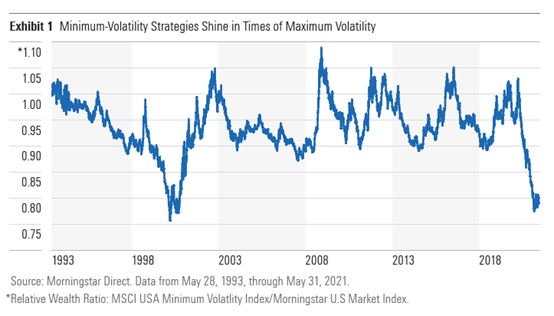
Low-volatility exchange-traded funds aim to give investors a smoother ride in stock markets. Being long stocks with less risk is a compelling proposition. So it’s little surprise that these funds have been popular. Over the trailing five years through February 2020, investors poured a combined US$30.2 billion of their hard-earned savings into U.S. large-cap ETFs in the U.S. that focus on dialing down volatility. This represented 306% organic growth over that three-year stretch. But the early-2020 market meltdown and subsequent rebound have put them to the test, and many investors have gotten spooked. These funds saw US$18.1 billion in net outflows from March 2020 through May 2021.
Here, I’ll look at how low-volatility ETFs performed in the 2020 market downdraft and subsequent recovery, examine the differences among them, and share my thoughts on how investors might use them to manage risk in their portfolios.
The Best of One World
Low-volatility strategies are at their best when markets are at their worst. Exhibit 1 is a relative wealth chart that plots the growth of the MSCI USA Minimum Volatility Index divided by the growth of the Morningstar U.S. Market Index. When the line slopes upward, the minimum-volatility index is outperforming the broad market index, and vice versa. The upward spikes coinciding with the bursting of the dot-com bubble, the global financial crisis, and the coronavirus pandemic are a testament to the strategy’s efficacy; it has taken some of the sting out of stock-market drawdowns.
But there are trade-offs. Investors can’t have the best of both worlds. Low-volatility strategies will tend to lag in bull markets. This is most evident in the downward slope of the line that spans the better part of the 1990s and more recently in the post-pandemic crisis rebound. This is what investors in these strategies signed up for. But following the most acute episode of underperformance in the history of the MSCI benchmark, a lot of them clearly aren’t willing to suffer through it.
A year-plus of underperformance isn’t an indictment of these strategies. Over the long term, investors in low-volatility funds are betting that this trade-off between losing less on the downside and not gaining as much on the upside will result in marketlike returns with less risk. The nearly three decades of performance history illustrated in Exhibit 1 show that it has generally been a solid bet—over a long enough horizon.

Weathering the Storm
How did low-volatility ETFs weather the storm in the first quarter of 2020? In a word: differently.
During the pandemic-induced sell-off, iShares MSCI USA Minimum Volatility ETF USMV’s maximum drawdown (the depth of its decline from its mid-February peak) was 33.1%. Invesco S&P 500 Low Volatility ETF SPLV’s maximum drawdown was 36.3%. iShares Core S&P Total U.S. Stock Market ETF ITOT—a proxy for the broader U.S. market— experienced a maximum drawdown of 35.0%. USMV performed as expected during this episode; SPLV did not. That said, investors should not expect these funds to bat 1.000, outperforming the market each time it dips. The longer the time frame, the more likely it is you’ll see this relationship hold. Indeed, from November 2011 (the first full month following USMV’s inception) through May 2021, USMV and SPLV had respective downside-capture ratios of 62.8% and 60.8% versus the Morningstar U.S. Market Index.
These funds’ recent performance underscores three key points that investors must keep in mind when assessing the merits of these funds and deciding where they might fit within their portfolios: 1) You’re trading upside participation for downside protection; 2) results may vary from fund to fund; 3) low volatility does not mean no volatility—just less.
In part 2 of this article, we will continue to look at how different low volatility strategies may differ.
©2021 Morningstar. All rights reserved. The information, data, analyses and opinions presented herein do not constitute investment advice; are provided as of the date written, solely for informational purposes; and subject to change at any time without notice. This content is not an offer to buy or sell any particular security and is not warranted to be correct, complete or accurate. Past performance is not a guarantee of future results. The Morningstar name and logo are registered marks of Morningstar, Inc. This article includes proprietary materials of Morningstar; reproduction, transcription or other use, by any means, in whole or in part, without prior, written consent of Morningstar is prohibited. This article is intended for general circulation, and does not take into account the specific investment objectives, financial situation or particular needs of any particular person. Investors should consult a financial adviser regarding the suitability of any investment product, taking into account their specific investment objectives, financial situation or particular needs, before making any investment decisions. Morningstar Investment Management Asia Limited is licensed and regulated by the Hong Kong Securities and Futures Commission to provide investment research and investment advisory services to professional investors only. Morningstar Investment Adviser Singapore Pte. Limited is licensed by the Monetary Authority of Singapore to provide financial advisory services in Singapore. Either Morningstar Investment Management Asia Limited or Morningstar Investment Adviser Singapore Pte. Limited will be the entity responsible for the creation and distribution of the research services described in this article.












.png)









